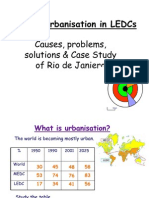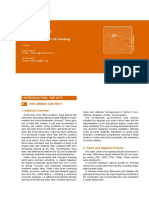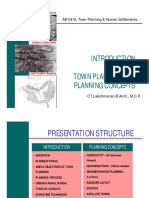Brazil Case Study
Brazil Case Study
Uploaded by
Lucas NgCopyright:
Available Formats
Brazil Case Study
Brazil Case Study
Uploaded by
Lucas NgOriginal Description:
Copyright
Available Formats
Share this document
Did you find this document useful?
Is this content inappropriate?
Copyright:
Available Formats
Brazil Case Study
Brazil Case Study
Uploaded by
Lucas NgCopyright:
Available Formats
Brazil: a national migration case study
Push factors:
The Sertao is a semi-arid area in North East brazil
Poverty: of the 208 million people in Brazil, 26% population is in poverty.
Few jobs except farming
Poor health facilities
Few schools
Little entertainment, especially for young people.
Pull factors:
Rio de Janeiro now has half a million homeless, 1.5 million living in favelas (shanty towns) and another 1 million
living in poor quality local authority housing.
That means that half the population of Rio is living in poor quality housing, or worse.
The hope of better work and the chance to make money
Better schools
Better healthcare
More entertainment
Problems (Housing):
There are over 700 favelas in/near to Rio, each with more than 60 families.
The largest of them is known as Rocinha.
Favelas are not very stable – most are built on steep, unused hillsides from any materials available – and thus
storms and landslides are a problem.
In 1988 storms caused 200 deaths.
As they are on the base of hills, sewage from favelas further up the hill may stream through the favela.
Problems (Crime):
Favelas are often perceived as areas of organized crime.
This is acting as a push factor causing well-off residents to leave the city for places such as Barra de Tijuca.
Tourists on Rio’s beaches are advised not to take valuables with them.
Problems (Traffic):
There is severe congestion due to winding mountain routes.
Thus, there is noise, light and sound pollution
Problems (Pollution):
A thick, polluted smog shrouds Guanabara Bay.
In favelas the rubbish is not collected and so piles up.
Solutions (Self-help):
Residents of Rocinha have slowly transformed their favela into a small city, built with better materials.
They have set up shops and small industries.
The authorities, having accepted the existence of favelas, now work with the residents.
They have helped to add electricity and satellite TV, paved and lit the streets and added water pipes.
However, improvements are restricted by the high density of housing and the steep hillside.
Solutions (Site and Service Schemes):
Even though the residents of favelas can develop their home, they cannot provide basic infrastructure.
So, some governments, the World Bank and leading charities have set up these schemes.
They provide a site, basic building materials, and links to electricity, water and drainage.
You might also like
- Things I Know To Be TrueDocument1 pageThings I Know To Be TrueLucas NgNo ratings yet
- IB Geography Option G NotesDocument23 pagesIB Geography Option G NotesRiko Malpense100% (12)
- Site Surveying Report (Levelling)Document12 pagesSite Surveying Report (Levelling)shumwenjun80% (5)
- Geoactive Squatter Redevelopment in RioDocument4 pagesGeoactive Squatter Redevelopment in Riosalohb01100% (1)
- Fracture by Daniel MadisonDocument12 pagesFracture by Daniel MadisonLucas Ng33% (3)
- Causes, Problems, Solutions & Case Study of Rio de JanieroDocument25 pagesCauses, Problems, Solutions & Case Study of Rio de JanieroMarsha Archie Ho Jia-YiNo ratings yet
- Rural Urban Migration in LEDCsDocument25 pagesRural Urban Migration in LEDCsMalia DamitNo ratings yet
- An Environmental Management Plan For The City of Rio de JaneiroDocument27 pagesAn Environmental Management Plan For The City of Rio de JaneirokelvinNo ratings yet
- Summary: Unit 5 Urbanisation in Developing Countries': Growth of World CitiesDocument5 pagesSummary: Unit 5 Urbanisation in Developing Countries': Growth of World CitiesCarito TranfoNo ratings yet
- Rural-Urban-migration - Study IGCSEDocument25 pagesRural-Urban-migration - Study IGCSEmahika gaurNo ratings yet
- Urban Issues: Rio Case StudyDocument4 pagesUrban Issues: Rio Case Studyxbox pro hiNo ratings yet
- 11 Geofactsheet - Brazillian FavelasDocument5 pages11 Geofactsheet - Brazillian Favelascherrylai40No ratings yet
- A Study of Rio de JaneiroDocument2 pagesA Study of Rio de Janeirohc2r5xj7qgNo ratings yet
- São Paulo: A Presentation On A Big CityDocument11 pagesSão Paulo: A Presentation On A Big CityjoeblakeyNo ratings yet
- 3-Rural-Urban Migration in LEDCsDocument1 page3-Rural-Urban Migration in LEDCskakakarennnnnNo ratings yet
- Geography - Development (Rural - Urban Settlement)Document32 pagesGeography - Development (Rural - Urban Settlement)jasmine le rouxNo ratings yet
- Geo NotesDocument4 pagesGeo NotesIan ChanNo ratings yet
- Squatter Camps. South Africa and Brazil Case StudyDocument3 pagesSquatter Camps. South Africa and Brazil Case StudyTembinkosi James GomendoNo ratings yet
- Case Study - Urban ChangeDocument1 pageCase Study - Urban Changebxzxmd75ryNo ratings yet
- Urban Issues Knowledge OrganiserDocument6 pagesUrban Issues Knowledge Organiserlajitap09No ratings yet
- Paper 2 Human Geog Case Studies SummariseDocument2 pagesPaper 2 Human Geog Case Studies SummariseiGotheInfoNo ratings yet
- The_Fight_of_the_Wayuu_Ethnic_Community-1Document4 pagesThe_Fight_of_the_Wayuu_Ethnic_Community-1HighTankNo ratings yet
- Urgent Appeal For Support Fo The Victims of Typhoon Pepeng in The Cordillera, PhilippinesDocument5 pagesUrgent Appeal For Support Fo The Victims of Typhoon Pepeng in The Cordillera, PhilippinesJasmin MutingNo ratings yet
- Urbanisation in Ledcs: Causes, Problems, Solutions & Case Study of Rio de JanieroDocument11 pagesUrbanisation in Ledcs: Causes, Problems, Solutions & Case Study of Rio de JanieroWonder MorNo ratings yet
- Development Challenges, South-South Solutions: June 2009 IssueDocument13 pagesDevelopment Challenges, South-South Solutions: June 2009 IssueDavid SouthNo ratings yet
- DSS 821 Assignment.Document8 pagesDSS 821 Assignment.Ojo Favour EbonyNo ratings yet
- Fill in The Research Organizer BelowDocument6 pagesFill in The Research Organizer Belowapi-320496148No ratings yet
- Case Study Revision Cards - Unit 3Document11 pagesCase Study Revision Cards - Unit 3arhowsonNo ratings yet
- PopulationDocument10 pagesPopulationGreyson EnockNo ratings yet
- UN-Habitat - The Challenge of Slums (Selected Sections)Document29 pagesUN-Habitat - The Challenge of Slums (Selected Sections)melieshetuNo ratings yet
- Research and Case Study of A SlumDocument16 pagesResearch and Case Study of A Slumshirin bobdeyNo ratings yet
- IRC Report HaitiAnniversaryDocument22 pagesIRC Report HaitiAnniversaryInterActionNo ratings yet
- Challenge of Slums-26-29Document4 pagesChallenge of Slums-26-29Astri Salahudin UbanNo ratings yet
- IGCSE Geography Case Study Booklet - Docx Version 1Document27 pagesIGCSE Geography Case Study Booklet - Docx Version 1Liza Liza100% (1)
- Case Studies Geography IGCSEDocument21 pagesCase Studies Geography IGCSERomeoNo ratings yet
- Haiti's Natural & Cultural VulnerabilityDocument12 pagesHaiti's Natural & Cultural VulnerabilityVanessaXiongNo ratings yet
- The Literacy Environment and The Acquisition and Application of Literacy: A Case Study From SenegalDocument15 pagesThe Literacy Environment and The Acquisition and Application of Literacy: A Case Study From SenegalNurlaela PujiantiNo ratings yet
- Wcbgeographycasestudies 130506104619 Phpapp02Document9 pagesWcbgeographycasestudies 130506104619 Phpapp02Mel KaneNo ratings yet
- 1. World Cities Knowledge OrganisersDocument1 page1. World Cities Knowledge Organisershheshini12No ratings yet
- Rio de Janeiro Factfile PDFDocument1 pageRio de Janeiro Factfile PDFToni SerbanNo ratings yet
- Informative Speech OutlineDocument7 pagesInformative Speech Outlineapi-283865133No ratings yet
- Informal SettlementsDocument3 pagesInformal Settlementsnataliemuller.natsNo ratings yet
- Camiguin IslandDocument21 pagesCamiguin IslandJoel MadjosNo ratings yet
- Dharavi - A City Within A CityDocument2 pagesDharavi - A City Within A CityChabbi KhadijaNo ratings yet
- Haiti Progress Report 2010Document25 pagesHaiti Progress Report 2010OxfamNo ratings yet
- Theme 9 Caribbean SocietyDocument25 pagesTheme 9 Caribbean Societychavela johnNo ratings yet
- Current Global Rates:: Population MovementsDocument11 pagesCurrent Global Rates:: Population MovementslNo ratings yet
- MODULE 2 - Part 3Document17 pagesMODULE 2 - Part 31DC19AT076 Saarika MNo ratings yet
- Problems of Urban Growth in LedcsDocument5 pagesProblems of Urban Growth in Ledcsapi-25904890No ratings yet
- Case Study of International MigrationDocument28 pagesCase Study of International MigrationAlejandra PiazzollaNo ratings yet
- 2nd SummaryDocument2 pages2nd SummaryJessica AraujoNo ratings yet
- Megacities - LagosDocument4 pagesMegacities - LagosRichard HampsonNo ratings yet
- Sewage Problem in Taimoor Nagar Solved Due To EffortsDocument10 pagesSewage Problem in Taimoor Nagar Solved Due To EffortsRahul ChandraNo ratings yet
- Lebanon Country Profile: Urban ContextDocument10 pagesLebanon Country Profile: Urban ContextLashvarNo ratings yet
- R10 Case StudyDocument6 pagesR10 Case StudyShielaMaeFernandezNo ratings yet
- Speech For CATDocument4 pagesSpeech For CATkingwill544No ratings yet
- Difference Between Rural and Urban LifeDocument32 pagesDifference Between Rural and Urban LifeTwinkling Kainat100% (2)
- Havana PDFDocument40 pagesHavana PDFΚωνσταντίνος ΓκάργκαςNo ratings yet
- Perlman Janice, The Myth of Marginality RevisitDocument36 pagesPerlman Janice, The Myth of Marginality RevisitLuisa F. Rodriguez100% (1)
- HIC Document 2668 20191127 0639Document7 pagesHIC Document 2668 20191127 0639Jaesma Alegre AsinasNo ratings yet
- Bolivia - Culture Smart!: The Essential Guide to Customs & CultureFrom EverandBolivia - Culture Smart!: The Essential Guide to Customs & CultureNo ratings yet
- Christianity Notes (Teachings)Document10 pagesChristianity Notes (Teachings)Lucas NgNo ratings yet
- Algorithms PowerpointDocument1 pageAlgorithms PowerpointLucas NgNo ratings yet
- Dofe Silver Physical Section at Castle Climbing Centre: Weeks Date SignatureDocument1 pageDofe Silver Physical Section at Castle Climbing Centre: Weeks Date SignatureLucas NgNo ratings yet
- How Do Buddhists Make Moral DecisionsDocument26 pagesHow Do Buddhists Make Moral DecisionsLucas NgNo ratings yet
- Revision: Birth StoriesDocument6 pagesRevision: Birth StoriesLucas NgNo ratings yet
- Gambia: A Case Study On A Youthful Population Structure: ReasonsDocument1 pageGambia: A Case Study On A Youthful Population Structure: ReasonsLucas NgNo ratings yet
- How Do Buddhists Make Moral DecisionsDocument26 pagesHow Do Buddhists Make Moral DecisionsLucas NgNo ratings yet
- A Separate PeaceDocument2 pagesA Separate PeaceLucas NgNo ratings yet
- Metals and Non MetalsDocument2 pagesMetals and Non MetalsLucas NgNo ratings yet
- HPs PDFDocument54 pagesHPs PDFacesrspNo ratings yet
- Ac 2 BUSINESS PLANDocument4 pagesAc 2 BUSINESS PLANNeco Carlo Pal100% (4)
- The-Fate-of-Remnant (RWBY) PDFDocument55 pagesThe-Fate-of-Remnant (RWBY) PDFLeo Knøsgaard HebyNo ratings yet
- William Morris DavisDocument7 pagesWilliam Morris DavisB. R. HosenNo ratings yet
- Geographie 7 Annee-1Document19 pagesGeographie 7 Annee-1sadyotNo ratings yet
- Environmental Impact Accessment Lec1Document93 pagesEnvironmental Impact Accessment Lec1Debadrita Das0% (1)
- Time Place and Identity - Urbanism at BDPDocument144 pagesTime Place and Identity - Urbanism at BDPIlda Dobrinjic100% (2)
- Delhi Public School Bangalore North Class - 6 Geography Lesson-2 Globe: Latitudes and Longitudes Question Bank Notebook Question/AnswersDocument3 pagesDelhi Public School Bangalore North Class - 6 Geography Lesson-2 Globe: Latitudes and Longitudes Question Bank Notebook Question/AnswersSumukh MullangiNo ratings yet
- Hydrology of The Nile - Sutclif Etal PDFDocument192 pagesHydrology of The Nile - Sutclif Etal PDFakhseidNo ratings yet
- Montgomery City VitalityDocument25 pagesMontgomery City VitalityBerna YaylalıNo ratings yet
- 55-Porto Do Rio Grande Tabua 2023 0Document3 pages55-Porto Do Rio Grande Tabua 2023 0Sérgio AlmeidaNo ratings yet
- Bibliografi II SundalandDocument146 pagesBibliografi II SundalandAhmad ArifNo ratings yet
- Vasai Virar PlanDocument5 pagesVasai Virar Planherb089No ratings yet
- Pompeii and MT Vesuvius Week 9 1Document5 pagesPompeii and MT Vesuvius Week 9 1api-296545779No ratings yet
- Bibliography OasisDocument48 pagesBibliography OasisAlberto AlvarezNo ratings yet
- Structural Controls On The Positioning of Submarine Channels Morgan 2004Document7 pagesStructural Controls On The Positioning of Submarine Channels Morgan 2004Sepribo Eugene BriggsNo ratings yet
- Honors Biology 5 8 14 PresentationDocument18 pagesHonors Biology 5 8 14 Presentationapi-239943146No ratings yet
- Coastal Process StructureDocument49 pagesCoastal Process Structureshakirhamid6687No ratings yet
- Consulting ProposalDocument25 pagesConsulting ProposalHemam PrasantaNo ratings yet
- Mind Map AvalanchesDocument3 pagesMind Map AvalanchescgmaliaNo ratings yet
- Chapter 9 MassTransport PDFDocument38 pagesChapter 9 MassTransport PDFLuis Ramon Montilva MarquezNo ratings yet
- Seawater Temp Salin DenseDocument8 pagesSeawater Temp Salin DenseRajesh KumarNo ratings yet
- MAP6a. DTMP OF RURAL ROAD CLASS ADocument1 pageMAP6a. DTMP OF RURAL ROAD CLASS AGopi Raj PunNo ratings yet
- The World - Index of Charts at 1:3,500,000 or Comparable ScaleDocument2 pagesThe World - Index of Charts at 1:3,500,000 or Comparable ScaleOleh100% (2)
- 1991 Gully Erosion: Processes and ModelsDocument16 pages1991 Gully Erosion: Processes and ModelsMartha LetchingerNo ratings yet
- Earth & Space Grade 10Document62 pagesEarth & Space Grade 10EmemhsPulupandan75% (12)
- Used To Talking About Past Habits First WorksheetDocument2 pagesUsed To Talking About Past Habits First Worksheetali bettaniNo ratings yet
- Introduction To Town PlanningDocument17 pagesIntroduction To Town PlanningKripansh Tyagi100% (2)
- Estuaries: Life On The InterfaceDocument15 pagesEstuaries: Life On The Interfacebuena rosarioNo ratings yet



































































































